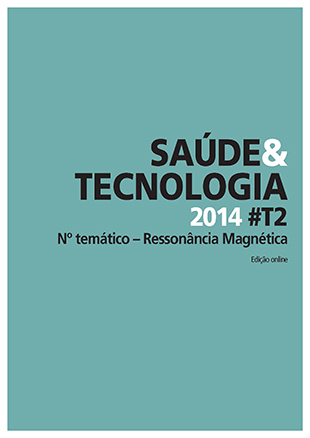Fat saturation in breast dynamic contrast-enhanced magnetic resonance imaging (DCE-MRI): comparison between DIXON and SPAIR techniques
DOI:
https://doi.org/10.25758/set.1024Keywords:
Breast magnetic resonance imaging, Breast cancer, Fat saturation, DixonAbstract
Introduction – Breast MRI with contrast injection is an indispensable tool for the characterization of breast lesions. To achieve this, good fat saturation is important in order to delimit the lesions. This study aims to assess quantitatively and qualitatively the fat saturation techniques in breast MRI, including SPAIR and Dixon techniques. Materials and methods – The study was performed in 1.5T MRI equipment and a specific breast coil was used. The study included an additional sequence with the Dixon fat saturation technique. Subsequently, the images obtained were analyzed and specific ROI was placed in the lesion, mammary gland, adipose tissue, and air, for both SPAIR and Dixon technique images. The obtained signal values were registered and, the SNR, CNR, and uniformity of fat saturation were calculated for all mentioned structures. Results – It was found that the fat suppression technique Dixon quantitative and qualitative results are better than the technique SPAIR. Conclusions – From this study, the use of the Dixon technique for fat saturation is recommended in the dynamic study sequences with contrast agents, specifically in breast MRI studies.
Downloads
References
Mendes AS, Mateus F, Nogueira J, Branco L, Rodrigues L, Dias SS, et al. Cancro da mama na ilha do Pico (1998-2008): uma perspectiva epidemiológica. Acta Med Port. 2011;24(5):687-94. Portuguese
Instituto Português de Oncologia Prof. Francisco Gentil. Registo oncológico nacional 2001. Lisboa: IPL-Lx; 2001.
Fletcher CD. Diagnostic histopathology of tumors. Vol I. 2nd ed. London: Churchill Livingstone; 2000. ISBN 9780443079924
Rakow-Penner R, Hargreaves B, Glover G, Daniel B. Breast MRI at 3T. Appl Radiol. 2009;(Mar):6-13.
Mann RM, Kuhl CK, Kinkel K, Boetes C. Breast MRI: guidelines from the European Society of Breast Imaging. Eur Radiol. 2008;18(7):1307-18.
O´Flynn EA, deSouza NM. Functional magnetic resonance: biomarkers of response in breast cancer. Breast Cancer Res. 2011;13(1):204.
Sinha S, Sinha U. Recent advances in breast MRI and MRS. NMR Biomed. 2009;22(1):3-16.
Niitsu M, Tohno E, Itai Y. Fat suppression strategies in enhanced MR imaging of the breast: comparison of SPIR and water excitation sequences. J Magn Reson Imaging. 2003;18(3):310-4.
Dogan BE, Ma J, Hwang K, Liu P, Yang WT. T1-weighted 3D dynamic contrast-enhanced MRI of the breast using a dual-echo Dixon technique at 3 T. J Magn Reson Imaging. 2011;34(4):842-51.
Le-Petross H, Kundra V, Szklaruk J, Wei W, Hortobagyi GN, Ma J. Fast three-dimensional dual echo dixon technique improves fat suppression in breast MRI. J Magn Reson Imaging. 2010;31(4):889-94.
Delfaut EM, Beltran J, Johnson G, Rousseau J, Marchandise X, Cotten A. Fat suppression in MR imaging: techniques and pitfalls. Radiographics. 1999;19(2):373-82.
Ma J. Dixon techniques for water and fat imaging. J Magn Reson Imaging. 2008;28(3):543-58.
Reeder SB, McKenzie CA, Pineda AR, Yu H, Shimakawa A, Brau AC, et al. Water-fat separation with IDEAL gradient-echo imaging. J Magn Reson Imaging. 2007;25(3):644-652.
Lauenstein TC. Spectral Adiabatic Inversion Recovery (SPAIR) MR imaging of the abdomen. MAGNETOM Flash. 2008;(2). Available from: http://clinical-mri.com/wp-content/uploads/software_hardware_updates/SPAIR_Lauenstein.pdf
Lee YS, Low CK, Rumpel H. STIR versus SPAIR in breast imaging: a case-based discussion. MAGNETON Flash. 2011;(1). Available from: http://www.healthcare.siemens.com/siemens_hwem-hwem_ssxa_websites-context-root/wcm/idc/siemens_hwem-hwem_ssxa_websites-context-root/wcm/idc/groups/public/@global/@imaging/@mri/documents/download/mdaw/mde2/~edisp/stir_versus_spair_in_breast_imaging-00016900.pdf
Beddy P, Rangarajan RD, Kataoka M, Moyle P, Graves MJ, Sala E. T1-weighted fat-suppressed imaging of the pelvis with a dual-echo Dixon technique: initial clinical experience. Radiology. 2011;258(2):583-9.
Ma J, Son JB, Bankson JA, Stafford RJ, Choi H, Ragan D. A fast spin echo two-point Dixon technique and its combination with sensitivity encoding for efficient T2-weighted imaging. Magn Reson Imaging. 2005;23(10):977-82.
Dogan B, Ma J, Hwang K, Yang WT. 3T breast MRI using Dixon technique. Proc Intl Conf Soc Magn Reson Med. 2009;17:4243.
Lin C. Quantitative evaluations of fat suppression techniques for breast MRI at 3T. Proc Intl Conf Soc Magn Reson Med. 2009;17:4543.
Kim H, Taksali SE, Dufour S, Befroy D, Goodman TR, Petersen KF, et al. A comparative MR study of hepatic fat quantification using single-voxel proton spectroscopy, two-point Dixon and three-point IDEAL. Magn Reson Med. 2008;59(3):521-7.
Carpenter CM, Pogue BW, Jiang S, Wang J, Hargreaves BA, Rakow-Penner R, et al. MR water quantitative priors improves the accuracy of optical breast imaging. IEEE Trans Med Imaging. 2011;30(1):159-68.
Graham SJ, Stanchev PL, Lloyd-Smith JO, Bronskill MJ, Plewes DB. Changes in fibroglandular volume and water content of breast tissue during the menstrual cycle observed by MR imaging at 1.5T. J Magn Reson Imaging. 1995;5(6):695-701.
Klifa C, Carballido-Gamio J, Wilmes L, Laprie A, Lobo C, Demicco E, et al. Quantification of breast tissue index from MR data using fuzzy clustering. Conf Proc IEEE Eng Med Biol Soc. 2004;3:1667-70.
Downloads
Published
Issue
Section
License
Copyright (c) 2022 Saúde e Tecnologia

This work is licensed under a Creative Commons Attribution-NonCommercial-NoDerivatives 4.0 International License.
The journal Saúde & Tecnologia offers immediate free access to its content, following the principle that making scientific knowledge available to the public free of charge provides greater worldwide democratization of knowledge.
The journal Saúde & Tecnologia does not charge authors any submission or article processing charges (APC).
All content is licensed under a Creative Commons CC-BY-NC-ND license. Authors have the right to: reproduce their work in physical or digital form for personal, professional, or teaching use, but not for commercial use (including the sale of the right to access the article); deposit on their website, that of their institution or in a repository an exact copy in electronic format of the article published by Saúde & Tecnologia, provided that reference is made to its publication in Saúde & Tecnologia and its content (including symbols identifying the journal) is not altered; publish in a book of which they are authors or editors the total or partial content of the manuscript, provided that reference is made to its publication in Saúde & Tecnologia.







